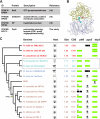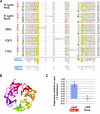A typhus group-specific protease defies reductive evolution in rickettsiae
- PMID: 19820087
- PMCID: PMC2786609
- DOI: 10.1128/JB.01077-09
A typhus group-specific protease defies reductive evolution in rickettsiae
Abstract
Phylogenomics reveals extreme gene loss in typhus group (TG) rickettsiae relative to the levels for other rickettsial lineages. We report here a curious protease-encoding gene (ppcE) that is conserved only in TG rickettsiae. As a possible determinant of host pathogenicity, ppcE warrants consideration in the development of therapeutics against epidemic and murine typhus.
Figures


References
-
- Andersson, S. G., and C. G. Kurland. 1995. Genomic evolution drives the evolution of the translation system. Biochem. Cell Biol. 73:775-787. - PubMed
-
- Banbula, A., P. Mak, M. Bugno, J. Silberring, A. Dubin, D. Nelson, J. Travis, and J. Potempa. 1999. Prolyl tripeptidyl peptidase from Porphyromonas gingivalis. A novel enzyme with possible pathological implications for the development of periodontitis. J. Biol. Chem. 274:9246-9252. - PubMed
Publication types
MeSH terms
Substances
Grants and funding
LinkOut - more resources
Full Text Sources
Research Materials
Miscellaneous

